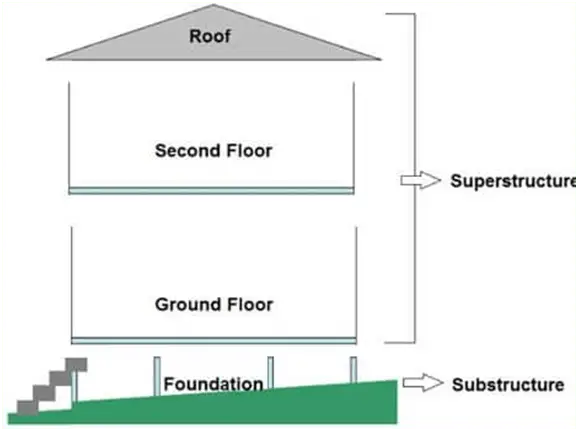DIFFERENCE BETWEEN SUBSTRUCTURE AND SUPERSTRUCTURE
The structure is a combination of structural members or components constructed to support the load and has a fixed position on the ground. There are two significant components of a building namely, superstructure and substructure. The foremost difference which also defines these components is that the part of the structure that is below the ground level is termed as substructure and the part above the ground is the superstructure.
Substructure
Part of the building that is below the ground is termed as a substructure. The primary role of a substructure is to transfer the load enforced by the superstructure on it to the soil below. Components of a substructure include the footing and the plinth. Structural engineers are responsible for calculating the load on the substructure and considerably design the beams, columns, and foundations in the substructure. The substructure is majorly constructed in plain cement concrete or reinforced cement concrete. After filling the stones, bricks, etc. till the plinth level a damp-proof course is laid on the top. This damp-proof course as the name suggests prevents the moisture to penetrate in the substructure and affects its durability.
Superstructure
Part of the building that is above the ground is termed as a superstructure. This superstructure serves the intention of building the structure. Components of the superstructure include beams, columns, floor, roof, wall, door, window, etc. thus making the superstructure larger than the substructure. This is a comparatively more complex component than the substructure as it needs to be designed taking into consideration the quality of space, aesthetics, use of the space, etc. along with the load. The material used and method of construction is also comparatively complex and extensive. Thus, the superstructure is that component of a building that is used, occupied, and witnessed by people.
To summarize the difference between substructure and superstructure,
Substructure
Superstructure
Part of the building that is beneath the ground level is the substructure
Part of the building that is above the ground line is the superstructure
The load imposed on the substructure is transferred to the soil beneath
Superstructure transfers the load of all its external and internal members to the substructure
The main purpose of a substructure is to transfer the entire load of the structure
The main purpose of a superstructure is to create a space to be occupied by the users
Elements include: foundation, plinth
Elements include floor, wall, column, beam, door, window, etc.
To conclude, both substructure and superstructure are important and need interdependency to complete a structure. If both these components are not correctly aligned or do not show efficiency, the entire structure will collapse.

